The 9.7" iPad Pro Review
by Brandon Chester on June 1, 2016 9:00 AM ESTDisplay Analysis
The 9.7" iPad Pro has what is by far the most interesting display I've seen on a tablet since the iPad 3, which was the first of the Retina displays. Samsung is arguably the only other vendor making advances with tablet displays, since they're the only company that ships a calibrated AMOLED. However, Samsung has been limited with the brightness they can push on the larger AMOLED displays, and at the end of the day when you set to sRGB the only advantage is the black level when there's not much ambient light to wash the display out.
With the iPad Pro Apple has improved upon the anti-reflective coating that they introduced with the iPad Air 2, and they've moved to a wider color gamut while also implementing a dynamic color feature called True Tone. I'll be talking about True Tone on the next page, but for now I'll be running 9.7" iPad Pro through our standard display workflow, along with an additional test to examine the accuracy within the DCI-P3 color gamut.
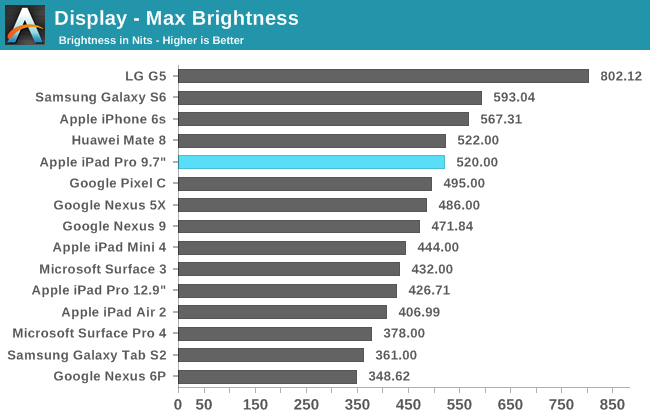
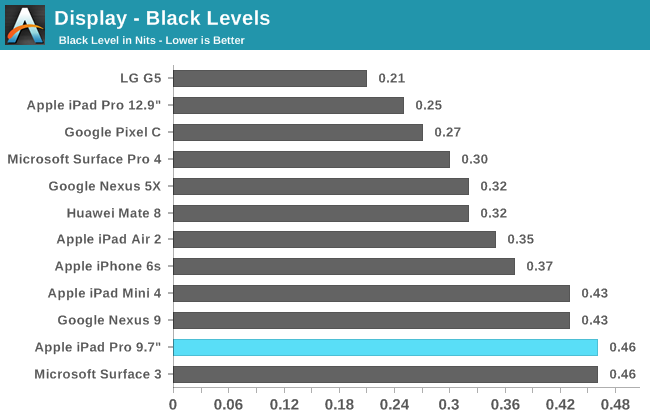
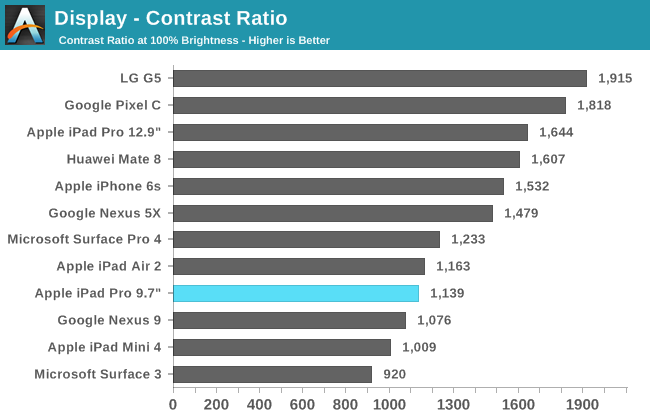
There are two things that I find surprising in the charts above. The first is that Apple actually exceeded their advertised 500 nit brightness. This puts it at the top of our brightness list for tablets, and that's no small feat. Apple's new backlighting array has enabled both a significantly wider gamut and a much higher brightness. Combined with their new anti-reflective coating, the 9.7" iPad Pro handily beats the larger model and the iPad Air 2 as the most usable tablet in bright ambient lighting.
While the 9.7" iPad Pro is quite bright, it doesn't do so well with black levels. Compared to the Pixel C, which has only a slightly lower brightness, the 9.7" iPad Pro's black level is much higher, and the contrast ratio is significantly lower as a result. It's also lower than Apple's 12.9" iPad Pro, and I verified Josh's brightness and black results for the 12.9" iPad against my own to confirm that he didn't just get an exceptional sample. I'm honestly a bit surprised that the gap between the two is so large, as the 9.7" iPad Pro's display is more advanced than the display of the larger model in several respects.
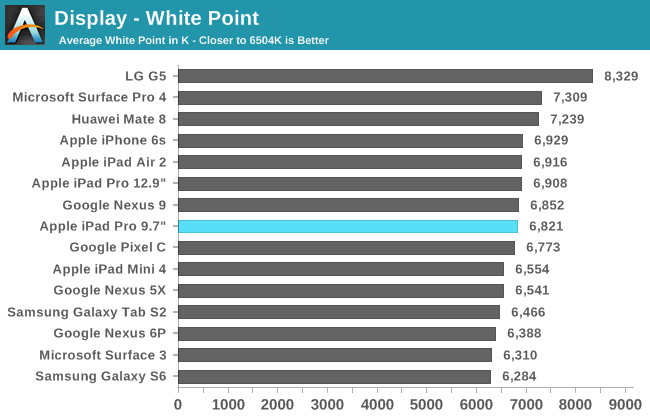

The 9.7" iPad Pro has great greyscale accuracy. Like most of Apple's products, there is a degree of blue shifting, but it's not quite as heavy as on their other products. The gamma is quite straight, and no shade of grey has a DeltaE that hits three, which is generally the goal. The accuracy isn't as high as the iPad Mini 4 which exhibited a surprisingly high degree of accuracy, but beyond the slight blue shift there's not really anything to complain about here.
DCI-P3 Gamut Saturation Sweep
The iPad Pro is Apple's second device that has moved to a wide color gamut. The first was the 2015 iMac with Retina 5K display, and from it we learned a number of things about Apple's implementation. The first thing to make note of is that the display conforms to the DCI-P3 gamut, but it doesn't use the corresponding 2.6 gamma that goes along with the standard. Using that gamma would be a mistake because no content coming on UltraHD Blu-ray is going to use that gamma function, so it's not really an issue in practice. While it remains to be seen how Apple's wide gamut devices will handle content that uses the SMPTE 2084 EOTF, Apple has brought color management to iOS and can transform content that uses a different gamma curve than the 2.2 gamma that the display targets.
Because Apple has implemented color management, they're able to accurately render anything designed for color spaces that sit within the DCI-P3 color space, with the most relevant one being sRGB. For devices with wide color gamuts and color management we'll be testing them against their target gamut and the sRGB gamut for our saturation tests. First up is the DCI-P3 saturation sweep, which uses 20% steps like our sRGB test but obviously targets the wider DCI-P3 gamut and uses Apple's target gamma of 2.2.
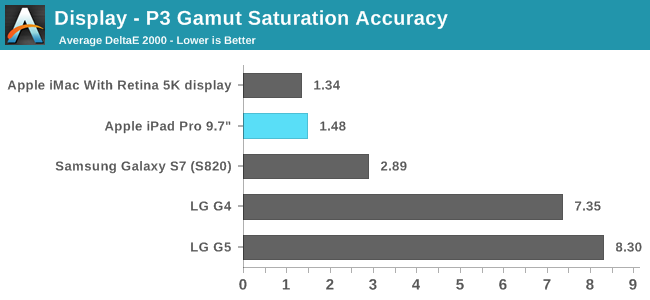
Because only a small group of devices claim to support this color gamut, I don't have as many points of comparison as we usually do. To be honest, the few that we have make it clear that Apple is currently without competition here. The other vendor actively advertising DCI-P3 gamut support is LG, and we've seen that the LG G4 and G5 do not even come close to actually meeting this goal regardless of which gamma target you use. In fact, they're bad enough that Samsung's accurate Adobe RGB mode on the Galaxy S7 accidentally beats them for P3 accuracy here, as it ends up being accurate in areas where the gamuts are very similar and only really has errors along red and with some deep saturations of colors that rely on red or blue.
As for Apple, they're the only vendor that actually covers the red-dependent segment of the gamut and their DeltaE values are incredibly low. The only issue I can see is that green is a bit inaccurate, which seems to be due to the display's blue shift. This is really me looking for criticism though, and with a DeltaE average of 1.48 the only device that beats it is a $2000 iMac.
sRGB Gamut Saturation Sweep
Because each 9.7" iPad Pro is individually calibrated, the color profile included is essentially a perfect description of the physical display's characteristics and color output. Because of this, the profile can be used to map colors from the sRGB color space to the display's native gamut with a high degree of precision, which is only limited by the display's color depth. In fact, this potentially allows for greater accuracy than if the display had been calibrated against the sRGB gamut in the first place, as the small error levels in Apple's calibration are accounted for by the profile and when doing color transformations.
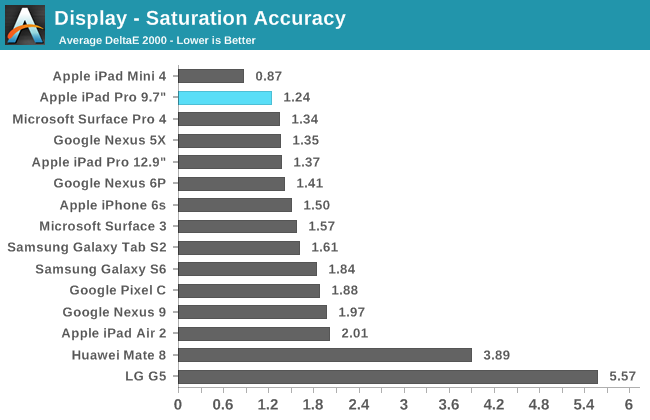
When displaying content designed for the sRGB gamut, the 9.7" iPad Pro is incredibly accurate. It's actually more accurate than the already near-perfect P3 results, with the red, blue, and green primaries being even closer to their target values. The only color that ever has an error above two is 20% saturated yellow, and the largest error is actually white which as we saw earlier is a bit too blue. Aside from those, every color has a DeltaE below two, and many are around or even below one. There's honestly not much more Apple could do here; this really is a professional-grade display.

As one would expect, the 9.7" iPad Pro has no trouble rendering the color mixtures from the GretagMacbeth ColorChecker test. The largest errors are actually the greyscale shades, and none of the DeltaE values for colors actually go above two. It's worth noting that the colors in this test are defined such that they should always be the same regardless of the color space, and so the fact that I've targeted sRGB has no change on the test outcome. For reference, changing the target to the P3 gamut produced an average DeltaE of 1.56, and I did that test at a later time so the error is well within the bounds of errors relating to the position of the meter on the display and the small inherent measurement error of the i1Pro 2 itself. This is a good example of Apple's color management at work, as my untagged image files were correctly inferred as having been created with the sRGB color space in mind, and transformed into the display's native gamut.
As far as tablet displays go, the 9.7" iPad Pro has the best one that I've seen. The combination of greatly improved peak brightness, extremely good color accuracy, an improved anti-reflective coating, and support for a wider color gamut all contribute to this, and the usefulness of aspects like the wide gamut will become even more apparent as time goes on and more content supporting it is released.



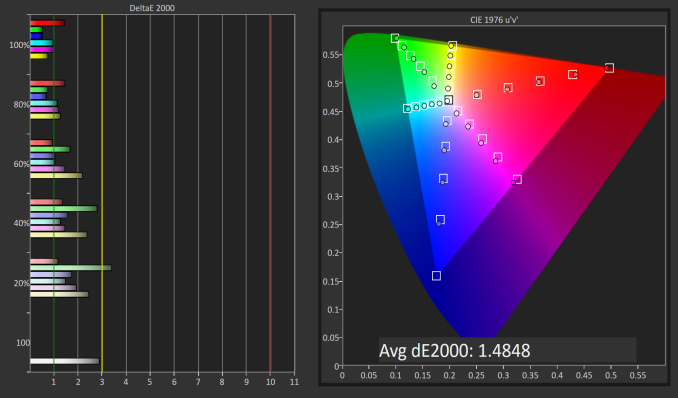
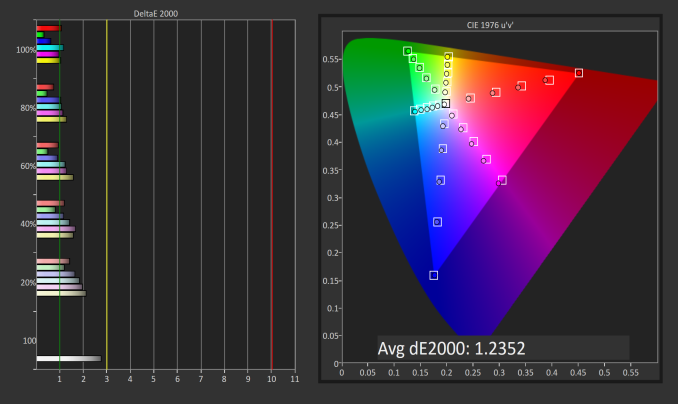
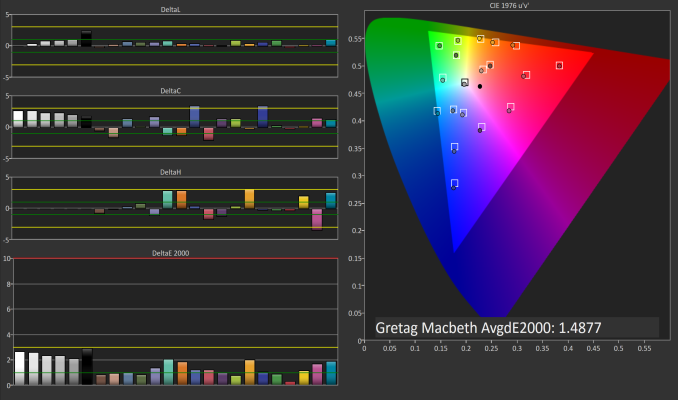








144 Comments
View All Comments
zeeBomb - Wednesday, June 1, 2016 - link
About time! As a Canadian: to buy or not to buy... That is the question.sachouba - Wednesday, June 1, 2016 - link
It's funny how the iPad Pro 9.7 is compared with the Galaxy S6, the middle range Nexus 5X or the 6 months old Huawei Mate 8 instead of the Galaxy S7, Huawei P9, Xiaomi Mi5 or other 2016 flagships when it comes to performance, display accuracy, recharging time, storage speed, etc.Even with a multicore CPU performance that is not as good as the best CPUs on smartphones right now (the Galaxy S7, for instance), a mediocre contrast (what is the point of having accurate colors if blacks cannot even be rendered properly ?), a price that is way too high, and a battery life that is far from impressive, the iPad Pro is praised in your review...
When it comes to the conclusion, it looks like Apple has invented the "True Tone Display", although it is only a copy of the 2-year-old and not-much-marketed Adapt Display from Samsung – which works great and adapts the white point according to the surrounding environment. You have fallen in Apple's trap of making people believe they invented everything that is known and unknown to Man thanks to aggressive marketing, which is disappointing, to say the least...
Brandon Chester - Wednesday, June 1, 2016 - link
You must have missed the LG G5 in the charts, which is a Snapdragon 820 device. I can't compare to devices that haven't been fully reviewed.Also, you may want to re-read the article to find out why True Tone is not the same as Adapt Display, and to clarify some other things that it seems you missed.
jlabelle2 - Wednesday, June 1, 2016 - link
Quite condescending statement when what you wrote was : "As you move to different environments the color temperature of the display shifts to match how your eye adjusts its perception of white depending on the temperature and brightness of the light around you."Which is exactly what Sachouba describe about Samsung Adapt Display...
jlabelle2 - Wednesday, June 1, 2016 - link
Since departure of Anand, Apple product reviews look like PR marketing speech, although the tests and content itself of the review do not match the speech :- "It’s not hard to conclude that the display on the 9.7” iPad Pro is the best display on any tablet" : except that the Surface (Pro 4) has be shown as having a better display (proven also by Displamate) and the Surface 3 is also shown to have a better display or at least as good with the huge avantage for someone really after color accuracy that they can be calibrated.
- "However, the significant hardware upgrades that Apple has made with this new iPad Pro are enough to make up the difference. the 9.7” iPad Pro is only $50 more than the 128GB iPad Air 2 used to cost" : an argument that makes no sense. EVERYTIME the year passes and a new phone or tablet is released, we used to have more power or a better camera or better performance ... for the SAME price. Otherwise, what is the point of the new model ? Except that here, it is more expensive than the previous model. And it is between 100 to 200$ more expensive than the iPad Air 2. And if you want really to take advantage of the real benefit of the Pro (the keyboard and / or the pencil), you need to spend 100 to 270$ !?! Just insane.
- "As far as performance goes, A9X is still the fastest chip that you’ll find in an ARM tablet" : why restricting tablet to ARM processor ? What does it change for the end user if a tablet is running an ARM chip or a x86 chip ? Especially when even a fanless core M smokes the A9X ? And this is good to make the apology of the power of the "small" iPad Pro but what application is taking advantage of this power versus the iPad Air 2 ? Especially with the 2Go of RAM only ?
- "In the end, the 9.7” iPad Pro is clearly the best standard-sized tablet on the market." : and here it is. How can it be objectively labelled like this ? It seems an excellent tablet but making this universal statement when it is the most expensive, it has not the best display (when it really counts for some), it does not have the best keyboard implementation, it is limited by its RAM, and the biggest asset is also its biggest issue of course as it suffers from limited external peripheric support and of some powerful application / program that people who want a powerful tablet with a good display usually are after (photo / video editing, graphist...). So the hardware strengths are constrained by the software capabilities.
Strange wordings and conclusions regarding a overall very nice tablet but with its share of drawback for its intended audience.
Lochheart - Wednesday, June 1, 2016 - link
Do you know any 10" Tablet with Core M ?digiguy - Wednesday, June 1, 2016 - link
Have a look: http://www.onda-tablet.com/onda-v919-3g-core-m-tab...kmmatney - Thursday, June 2, 2016 - link
I would not recommend an Onda tablet - I bought one myself and it was a bit of a nightmare. There is very little support. A windows update reversed my touchscreen and was a pain to fix. The glass on the screen cracked with very minimal pressure, and finally one-third of the touchscreen simply stopped responding to touch. This was all within 4 months. I finally just sold mine on ebay, with a cracked screen, and telling the buyer that it could only be used with a mouse and keyboard. At least mine was a lot cheaper than the one you linked to, but cannot recommend an Onda tablet...digiguy - Thursday, June 2, 2016 - link
I am not recommending either, just showing that it's feasibleLochheart - Friday, June 3, 2016 - link
Feasible... but does it works ? Throttling, Heat, 1h battery life...And... Windows !